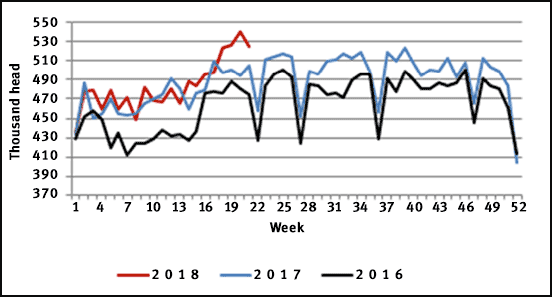Beef Production Heats Up
Increased fed-cattle numbers are available because of cow herd expansion.
Beef production is heating up in a big way as the long-awaited fed-cattle numbers have shaken loose. With the late-April, early-May bottleneck of tight supplies behind us, we now see the impressive ability of our nation’s packers to push production to the brink.
The week of June 4 had an estimated 658,000-head U.S. federally inspected cattle harvest and is the second largest this spring, surpassed only by the 667,000-head sum the week of May 14. That number was the largest one-week total since October 2011, although some weeks in 2013 were in the ballpark with figures upward of 650,000.

The theme lately has been centered on increased fed-cattle numbers available because of cow herd expansion, while drought in the South pushed cattle off of wheat pasture to feedlots ahead of schedule last fall. Additionally, packer profitability, estimated by analysts near $270 per head recently, has firms running big Saturday shifts at their plants to maximize throughput. Obviously that level of profit is an opportunity worth chasing.
In 2011, prior to the major drought impact of 2012, it was not uncommon to see weekly head counts larger than 660,000, with one week in June that year reaching as high as 690,000 head. However, packing-plant capacity has changed since 2011 with closures of plants by Cargill, PM Beef and National Beef from 2013 to 2015.
As such, the head counts we are now seeing represent plant utilization well ahead of capacity based on a 40-hour work week. Excluding the shortened Memorial Day week, we’ve seen six weeks now with more than 520,000 fed steers and heifers harvested, while CattleFax estimates industry capacity at 480,000 head in a 40-hour week (excluding cow plants). Packer profitability is working to keep feedlots current at this time — and the credit goes to beef demand, highlighted by increased export movement this year.

Editor’s Note: Paul Dykstra is a beef cattle specialist with CAB. Read more of Dykstra’s biweekly comments in the CAB Insider at www.cabpartners.com/news/cabinsider/.






